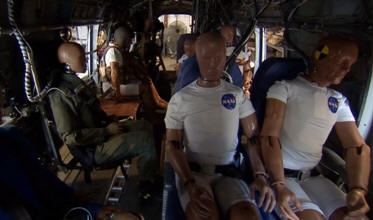|
"High speed cameras filming at 500 images per second
tracked each black dot, so after everything is over, we
can plot exactly how the fuselage reacted structurally
throughout the test," said NASA test engineer Justin
Littell. This was the first of two planned
tests using Navy-provided CH-46E Sea Knight fuselages. A
similar helicopter equipped with additional technology,
including high-performance, lightweight composite
airframe retrofits, will be used in a crash test next
summer. Both are part of the Rotary Wing Project in
NASA's Aeronautics Research Mission Directorate.
NASA will use the results of both tests in efforts to
improve rotorcraft performance and efficiency.
Researchers also want to increase industry knowledge and
create more complete computer models that can be used to
design better and safer helicopters. The ultimate goal of NASA's rotary wing research
is to help make helicopters and other vertical take-off
and landing vehicles more serviceable able to carry more
passengers and cargo quicker, quieter, safer and
greener, and lead to more extensive use in the airspace
system.
August 21, 2013 - NASA researchers will drop a
45-foot-long helicopter fuselage from a height
of about 30 feet to test improved seat belts and
seats and advance experimental techniques and
crashworthiness data. The crash is scheduled for
1 p.m. EDT Wednesday, Aug. 28, at NASA's Langley
Research Center in Hampton, Va. NASA is collaborating with the U.S. Navy, U.S.
Army and Federal Aviation Administration on the
Transport Rotorcraft Airframe Crash Test Bed
full-scale crash tests at Langley's Landing and
Impact Research Facility.
"We have instrumented a former Marine helicopter
airframe with cameras and accelerometers," said
lead test engineer Martin Annett. "Almost 40
cameras inside and outside the helicopter will
record how 13 crash test dummies react before,
during and after impact." During the test, onboard computers will record
more than 350 channels of data as the helicopter
is swung by cables, like a pendulum, into a bed
of soil. Just before impact, pyrotechnic devices
release the suspension cables from the
helicopter to allow free flight. The helicopter
will hit the ground at about 30 mph. The impact
condition represents a severe but survivable
condition under both civilian and military
requirements.
For the first time ever in any test, technicians
installed a video game motion sensor in the
helicopter. "We want to see if it is useful as
an additional way to track the movements of the
dummies," said test engineer Justin Littell. The outside of the fuselage also is new for this test.
Technicians painted one entire side in black polka dots
over a white background a photographic technique called
full field photogrammetry. Each dot represents a data
point. High-speed cameras filming at 500 images per
second track each dot, so after over the drop
researchers can plot and see exactly how the fuselage
buckled, bent, cracked or collapsed under crash loads. Another
crash test of a similar helicopter equipped with
additional technology, including composite airframe
retrofits, is planned for next year. Both tests are part
of the Rotary Wing Project in the Fundamental
Aeronautics Program of NASA's Aeronautics Research
Mission Directorate.
The Navy provided the CH-46 Sea Knight helicopter
fuselages, seats, crash test dummies and other
experiments for the test. The Army contributed a litter
experiment with a crash test dummy. The Federal Aviation
Administration provided a side-facing specialized crash
test dummy and part of the data acquisition system.
Cobham Life Support-St. Petersburg, a division of CONAX
Florida Corporation, also contributed an active
restraint system for the cockpit.
NASA will use the results of both tests in efforts to
improve rotorcraft performance and efficiency, in part
by assessing the reliability of high performance,
lightweight composite materials. Researchers also want
to increase industry knowledge and create more complete
computer models that can be used to design better
helicopters. The
ultimate goal of NASA rotary wing research is to help
make helicopters and other vertical take-off and landing
vehicles more serviceable able to carry more passengers
and cargo quicker, quieter, safer and greener. Improved
designs might allow helicopters to be used more
extensively in the airspace system.
|




